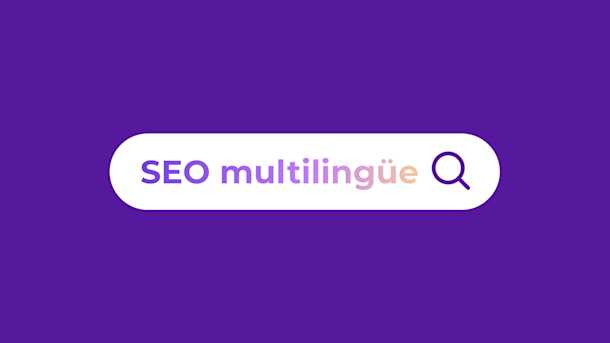Even if you’re operating in a market that primarily speaks English, you could be leaving business on the table if your search engine optimization (SEO) strategy is only focused on native English speakers.
Multilingual SEO can help you capture users who aren’t native speakers of the primary language in your market. Say your primary market is the United States, for example. Data from the 2018-2022 US census shows that the most common languages outside of English are Spanish, Chinese, and Tagalog. That means your market might not discover your business if your SEO strategy doesn’t account for search queries in the languages these users speak at home.
But nailing multilingual SEO requires more than just translating your english keywords into different languages. You also have to consider cultural differences, whether content is relevant to those consumers, and the technical aspects of SEO to get it right.
Let's dive into what SEO localization is, why it's important, and how to do it well.
What is multilingual SEO?
Multilingual SEO is the process of ranking for localized keywords and search terms with translated content so users discover it in their native language.
By implementing proper SEO techniques, brands can grow their business by reaching new customers and drive traffic to their site by ranking high on popular search results.
When your content is discoverable in more languages, it's easier for an audience that speaks those languages to learn who you are, what you do, and what you offer. Multilingual SEO helps brands stand out among the competition and build interest and trust with an audience as a company that takes their culutral background into consideration.
How is multilingual SEO different from international SEO?
Multilingual SEO focuses on offering content in multiple languages, whereas international SEO focuses on delivering content in different countries. International SEO therefore may or may not include multilingual SEO.
For example, if you’re primarily targeting Spanish-speaking markets, you could create an international SEO strategy that targets Mexico, Colombia, and Venezuela, without creating content in a new language.
International SEO could also require multilingual SEO, though. That same company could expand into France and the United States, which would require creating content in both French and English.
Finally, international SEO typically requires more technical work to signal to search engines that you want consumers in a different country to be able to discover your content.
The importance of multilingual SEO
If you’re branching out into a new language, SEO and localization are essential pieces of the puzzle.
All the typical rules of localization should still apply to your multilingual SEO efforts. Your translated keywords and content should take everything from cultural beliefs and the nuances of the language into consideration to make your content both accessible and searchable in that new language.
Start by conducting proper in-depth user research:
- Who is your target audience?
- What are their habits?
- What do they search for?
- What do they want to know more about, and what are their intentions for their search?
- What has been their response to the competition’s efforts to reach them?
Armed with this knowledge, your brand can find relevant keywords and tailor content to meet users where they already are. The goal is to make it easier for customers to find your content in their native language.
3 pillars of a multilingual SEO strategy
A multilingual SEO strategy involves regularly executing three major tasks: keyword research, content localization, and link building. It's critical to work with someone who speaks the language natively at all three stages.
Native speakers understand the context of keywords as they build lists, hold translations to the highest standard, and easily identify the right sites for backlinks by being able to read the site's content.
1. Keyword research
A multilingual SEO strategy requires keywords in the language you’re targeting. SEO tools like Semrush and Ahrefs can help you find these easily, but other resources like Google Search Console (GSC), Google’s country-specific domains, and Google Trends can help you find keywords for free.
Install GSC on your website to see which keywords people use to find your site today. Filter by your target language and use these as the foundation for your research.
If there aren’t any relevant keywords in your target language, start with a competitor. For example, Canva works with Smartling to translate content in subfolders of the canva.com domain. It uses these subfolders to target business owners in other languages, like canva.com/fr_ca/ for example, which targets French speakers in Canada.
Say you’re a Canva competitor. Looking through Canva’s site content could help you discover some seed keywords related to the French-speaking design market in Canada.
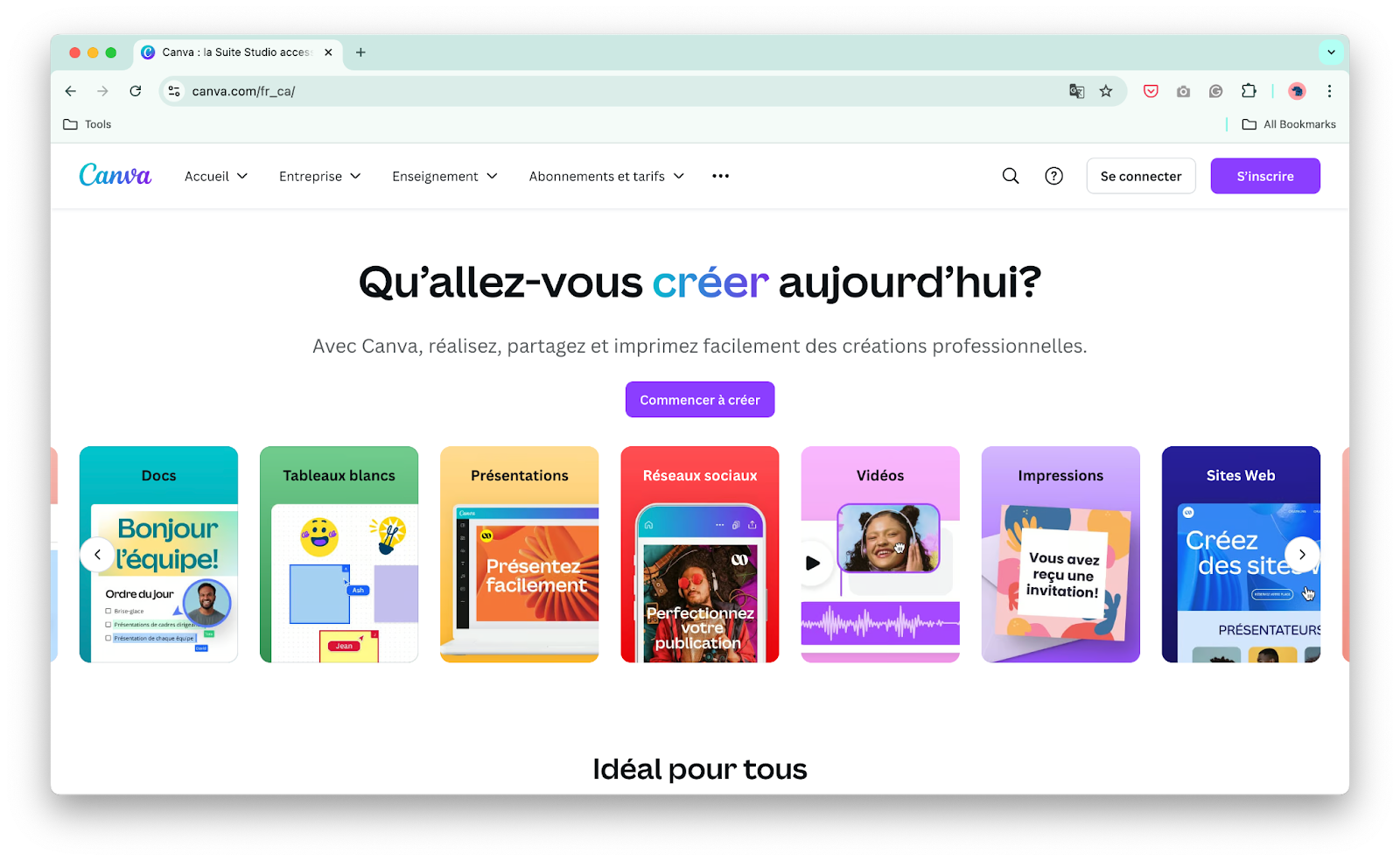 Canva’s homepage targeting french speakers in Canada (Source)
Canva’s homepage targeting french speakers in Canada (Source)
Canva’s website suggests these keywords might be a helpful starting point:
- “Création graphique en ligne,” meaning “online graphic design”
- “Modèles de conception,” meaning “design templates”
- “Éditeur de photos,” meaning “photo editor”
- “Outils de design,” meaning “design tools”
- “Graphisme pour les réseaux sociaux,” meaning “social media graphics”
Once you’ve got a starting point, you can take these keywords to Google to find more. If you’re targeting French speakers in Canada, you’ll want to visit google.ca to discover more keywords in that language.
Paste each of your starting keywords into Google, but don’t press search. Use the autocomplete suggestions to find keyword ideas. Then press search and use the related searches box to find even more.
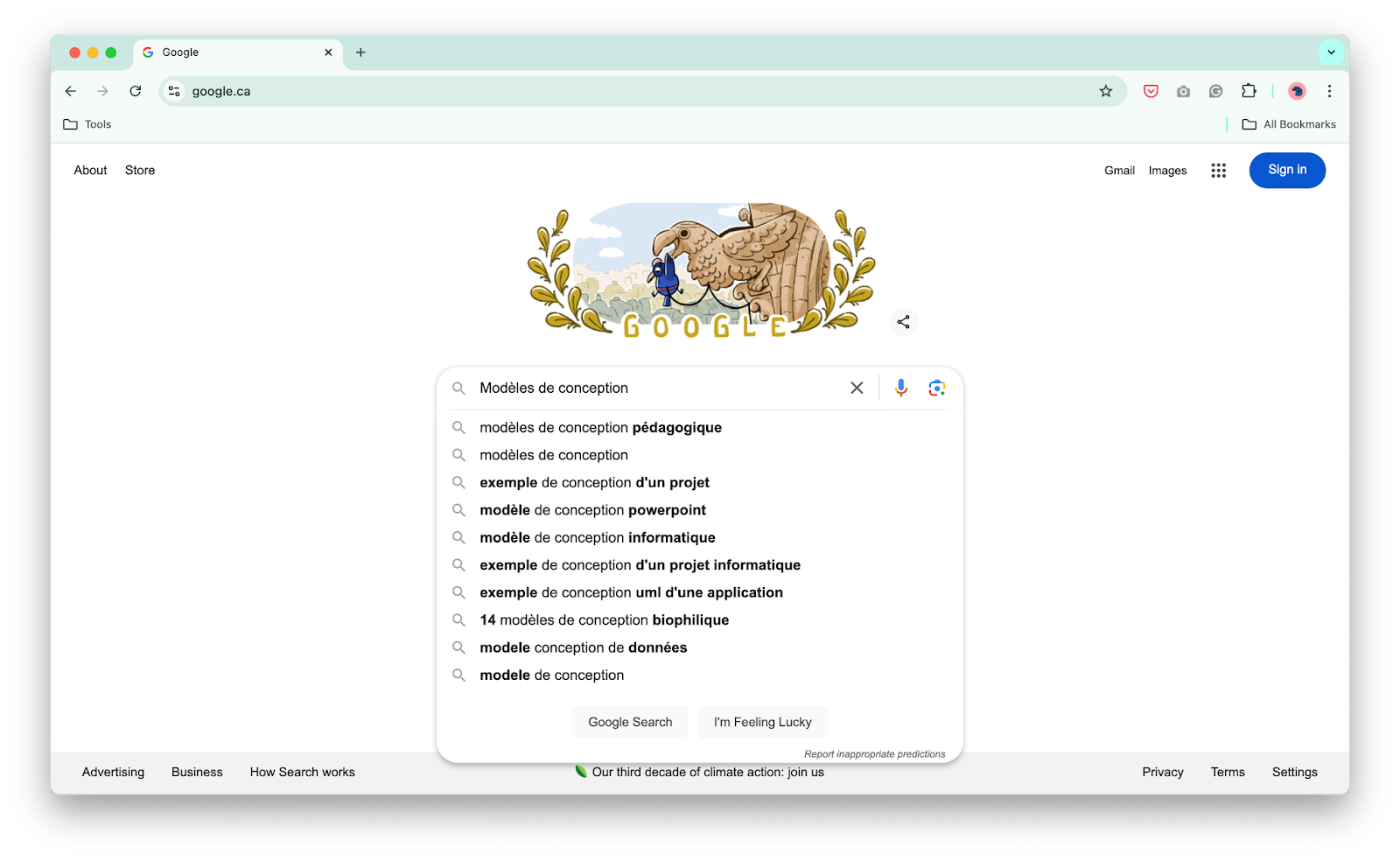 Google’s Canada homepage (Source)
Google’s Canada homepage (Source)
Once you’ve got a list of keywords you think might be relevant to your target audience, you can take them over to Google Trends to see if they’re worth targeting. This free tool displays data about search volume in specific locations over time.
The best keywords are those that are searched for at a high volume regularly, but don’t have a lot of relevant or helpful content currently ranking on the search engine results page (SERP).
 Google Trend results in Canada for the keyword “Modèles de conception” (Source)
Google Trend results in Canada for the keyword “Modèles de conception” (Source)
If you don’t speak the language natively, you’re taking a risk conducting the keyword research yourself. You might miss cultural nuances. Coinbase worked with Smartling to navigate translating the term “wallet” more effectively in different languages, which has a unique meaning for cryptocurrency owners.
2. Localize your content
When translating your site's content, you want to take into consideration the cultural differences that might need addressing.
For example, Yext works with Smartling to build translations across 175 global platforms. Yext has a site subdomain that targets German speakers at yext.com/de. When you compare the translated text on its homepage to that of yext.com, you’ll find that the headlines are not word-for-word translations.
- English tagline: Turn Your Digital Presence into a Differentiator
- German tagline: Use your digital presence as a unique selling point (Nutzen Sie Ihre digitale Präsenz als Alleinstellungsmerkmal)
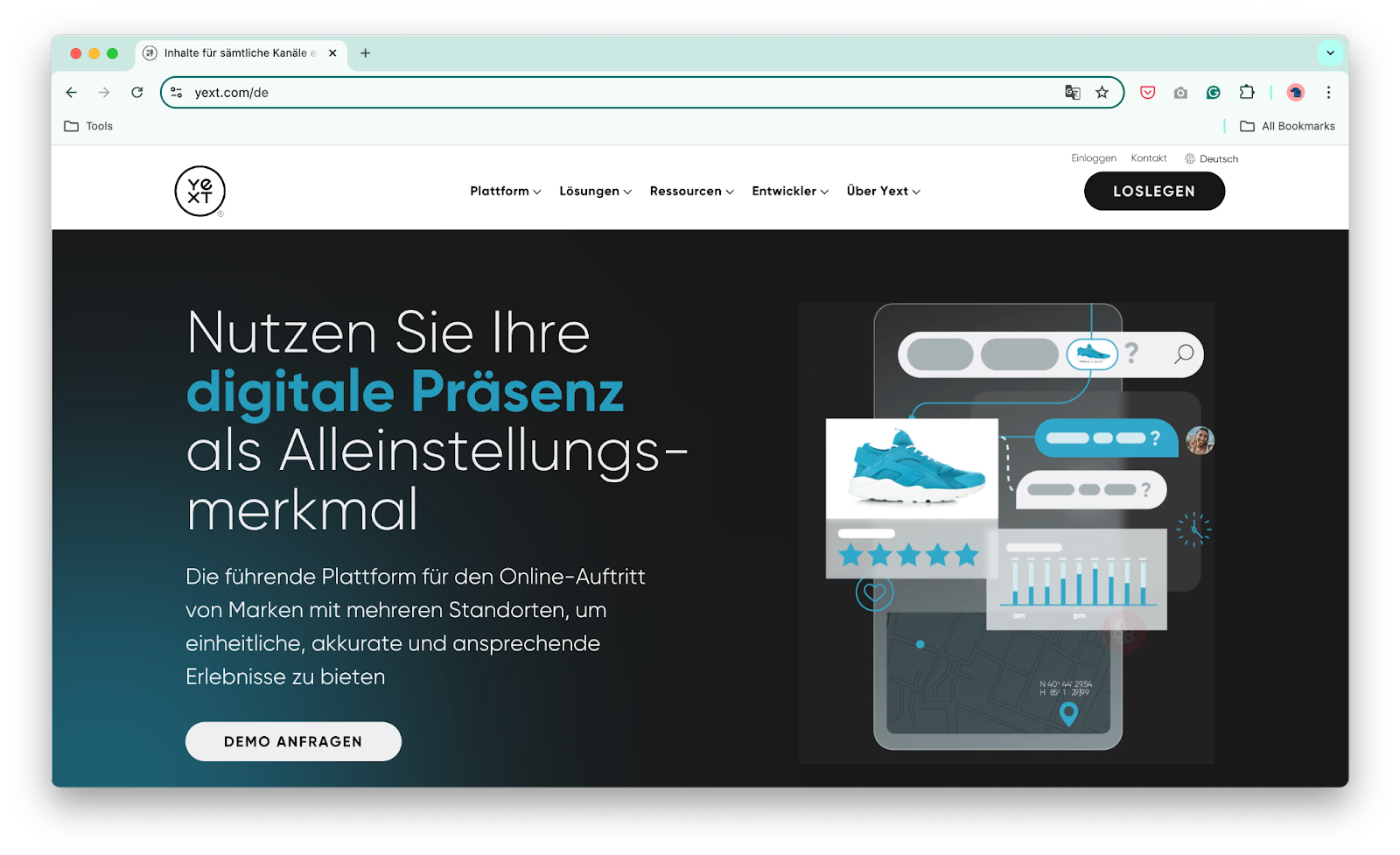 Yext’s homepage translated into German (Source)
Yext’s homepage translated into German (Source)
The difference in this translation might reflect a preference for formality or the type of call to action that resonates with German versus English speakers.
Here are some other elements to look out for when adapting your current content for different languages, especially if you’re targeting them across borders:
- Clothes sizing standards
- Date formats, like MM-DD-YYYY or DD-MM-YYYY
- Time formats and timezones
- Seasonality, as winter and summer occur at different times in hemispheres
- Measurements, like the metric system and the imperial system
- Text direction, like right-to-left, left-to-right or vertical
- Idioms, expressions, metaphors, jokes, or slang
- Currency symbols
- Payment methods
- Dialects
If you pay attention to these details, you’ll end up with content that’s high-quality enough to engage your audience in different languages and attract backlinks, which is a key part of climbing in keyword rank.
3. Build links
Backlinks will help you build your site’s authority in a new language, but they’re most important when you create a new domain or subdomain (more on that later).
Say your business is based in the US, and your site (example.com) has high authority. If you’re hosting Spanish content in a subfolder at example.com/es, you won’t have to build as many backlinks as you would when building a new domain or subdomain to reach Spanish speakers within the US.
However, if you wanted to reach Spanish speakers in Spain, you’d need to build backlinks from high-authority websites that have Spanish content in Spain.
You’ll naturally attract backlinks if you’ve focused on creating high-quality translations with sensitivity to cultural differences. However, you can also reach out directly to websites and ask them to add backlinks to your website.
5 best practices for multilingual SEO
Whether you’re diving into multilingual SEO for the first time or shoring up content on sites you’ve already translated, you want to make sure search engines like Google can easily discover your content.
You’ll need to keep some technical best practices in mind, as well as ensure that your content continues to be incredibly valuable and written to high standards (just like you would for any SEO strategy). Consider these Smarling-approved tips:
1. Choose the right URL structure
Your site’s URL matters for multilingual SEO. It helps search engines index your site properly. There are a few ways to structure your URL, but a subfolder is the best option for beginners.
A subfolder uses your current domain to organize content in different languages. It’d probably look something like these examples:
You could also set up a subdomain or an entirely different domain to host content in other languages. Those URL structures would look something like this:
- Subdomain: es.yoursite.com
- New domain: www.yoursite.es
Both types of URLs are effective if you’re trying to reach consumers in a different country. Audiences are familiar with their country’s dedicated domains, like .com in the US or .co.uk in the United Kingdom.
But you’ll need to purchase and manage multiple domains, which can be a large investment. You’ll also need to build links to each domain individually to build SEO authority.
The upside is that you can host your domain locally, which could improve your page load times.
2. Implement hreflang tags
Hreflang might sound complex, but it’s just a snippet of code. Its purpose is to tell search engines your location and the location of those you want to target. This helps search engines serve customers the right web page within search results.
To implement a hreflang tag, paste it into the HTML head section of your webpage’s code. The HTML head section is specifically reserved for tags that don’t display anywhere on the webpage, but browsers and search engines still use them to analyze your site.
Here’s what a hreflang tag looks like:
 The section of this code that reads hreflang=“XX” needs to contain the correct ISO 639-1 language code for each language. In the above examples, “es” is the correct code for Spanish (Español), and “en” is the correct code for English.
The section of this code that reads hreflang=“XX” needs to contain the correct ISO 639-1 language code for each language. In the above examples, “es” is the correct code for Spanish (Español), and “en” is the correct code for English.
Use hreflang tags on all pages that you translate into multiple languages.
4. Translate metadata
Each of your web pages has metadata that helps search engines list your page in search results.
That data should reflect the languages you’ve chosen as a part of your multilingual SEO strategy. Some of the most important examples include:
- Title tag: The title that appears on a search engine results page (SERP)
- Meta description: The description below the title tag
- URL slug: The part of your URL that comes after your domain name, like /blog/title-ofblog
- Internal links: The links that link to other translated articles
If you’re using Smartling’s platform already, head over to our help center, where we break down the easy ways to swap meta tags.
5. Keep your content fresh
A big part of any SEO strategy is frequently updating content. Search engines are more likely to prioritize your content when it’s relevant and up to date.
Here are some ideas for keeping your content fresh:
- Update statistics and research in your articles each year
- Remove outdated information or add new points to listicles
- Add more recent examples from your business or pop culture
- React to new opinions in the market
Not every article is worth updating. As a general rule of thumb, you’ll want to frequently revise your top performers and underperformers that are relevant to your business.
Get high-quality translations consistently across multiple languages
If you’re going to rank well for target keywords in a new language, you need a lean, mean translation machine. Look for a language services provider (LSP) that also offers a translation management system (TMS) that can automate much of the process without sacrificing quality.
The right solution will integrate with your current tech stack, offer automated workflows, and connect you with native speakers of the languages you’re targeting.
Analyze your tech stack
If your team is constantly moving back and forth between several different systems to get content translated and published, they’re sacrificing valuable time and effort.
When choosing an LSP, you want its TMS to integrate with the tools you already use every day. Consider tools like your content management system, development tools, email platforms, or knowledge bases. You want a TMS that integrates with every tool that touches SEO content before it’s published.
Smartling integrates with over 40 popular technology partners like Contentstack, Adobe, Drupal, Oracle, Google, and many more, so translations move smoothly between systems.
Smartling’s integration with Adobe Experience Manager (AEM) improved IHG Hotels & Resorts' translation quality by 33%.
Even as we’ve significantly expanded our brand portfolio over the last 12 months, the costs to deliver a new language have not gone up. The Smartling connector makes our translation process more efficient from beginning to end. We’re saving time every step of the way — from the Smartling dashboard through to content management in AEM.
–Chris Hamilton, Director of Digital Experience for Marketing Channels & Application, IHG
Build your workflow
Then, you’ll want to consider all of the people who must collaborate within your workflow and the systems they use to translate and launch translated content successfully.
For example, a workflow within Smartlin’s TMS might look like this:
- Content enters the system and translation memory is used to ensure it’s translated correctly
- AI translates the content based on those rules
- Glossary terms saved in the system are identified and applied
- Expert linguists review your translation
- Content is published back to your site
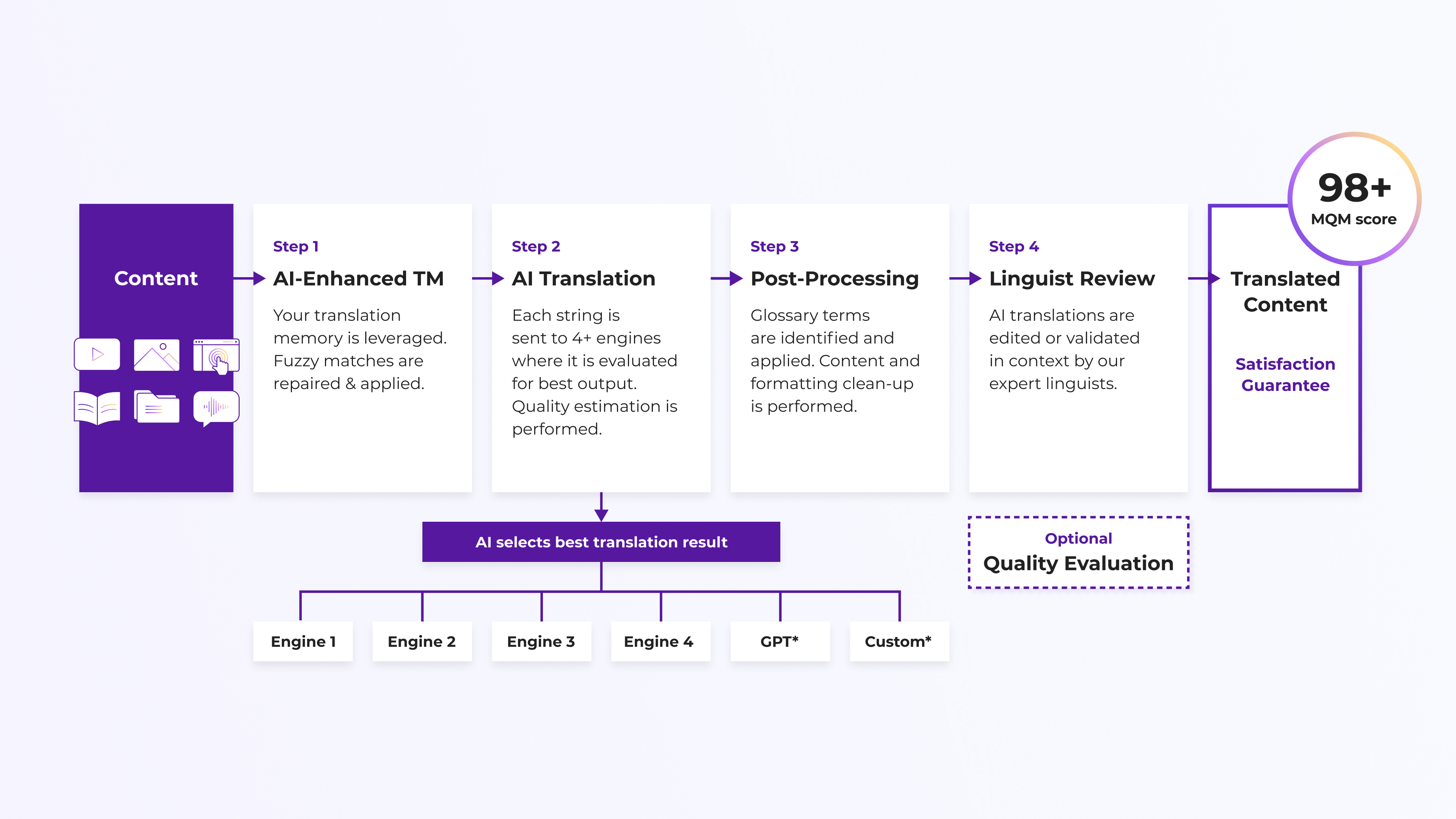 Smartling’s AI-powered human translation solution (Source)
Smartling’s AI-powered human translation solution (Source)
BMJ, a global healthcare company, used to have a convoluted translation process that slowed company growth. It had a high volume of translations and its teams needed to find a way to speed up the process. Smartling accelerated BMJ’s translation workflows by 54%, primarily by eliminating the need to manually handle files.
We used to have to download and upload each unit of content multiple times, passing it back and forth between translation providers and reviewers before we could publish it. Now, thanks to Smartling, we have a smoother workflow and can dedicate our time to ensuring timely delivery of translated content.
–Eleonora Rossotto, Translation Manager, BMJ
Determine the most effective way to translate content
You can rely on machines or humans to translate content, or you can use a combination of the two. It ultimately depends on your translation needs:
- Artificial intelligence (AI) tools like Smartling's AI Translate Toolkit are great for translating straightforward content, like a technical manual.
- More nuanced content, like a website homepage, is better off being handled by the translation services of a professional linguist.
- Higher volume content, like translating an entire library of SEO content, might need both. Smartling’s AI-Powered Human Translation (AIHT) provides the best of both worlds.
AIHT is the ideal way to keep translation quality high while staying cost efficient and moving fast at the same time.
One multi-billion dollar enterprise software company saved $3.4 million in translation costs in the first year with AIHT. It’s now able to publish content 50% faster while keeping an average multidimensional quality metrics (MQM) quality score of 99+.
Optimize your translation process
When you first break into a new language, you’ll make many decisions about how to word brand messaging in that language.
After all that work, you’ll want to make sure they’re used in every translation moving forward. You need a TMS that keeps this information in a glossary or style guide using translation memory. That way, each new piece of content will be evaluated using those standards.
Personio keeps its glossary, style guide, and translation memory in Smartling’s TMS. This allows any external linguists to easily refer to them to ensure translations are consistent.
Approved translations are automatically added to Smartling’s translation memory and used for future Personio translations.
Produce quality translations with Smartling
Never sacrifice quality for search rankings. The best way to rank high in search results in a new language is to write informative, high-quality content.
If a prospective customer sees glaring grammatical and linguistic errors, you’re likely to lose their trust and their business.
A cloud translation management system like Smarling’s is a scalable and easy way to produce high-quality translations quickly and at a reasonable cost.
When you reach international customers with well-translated content, you are more likely to reap the benefits of increased engagement, accelerated conversions, and a foundation of trust on which future business can grow.
Book a meeting with Smartling to talk to a professional about how multilingual SEO can increase your website traffic.
